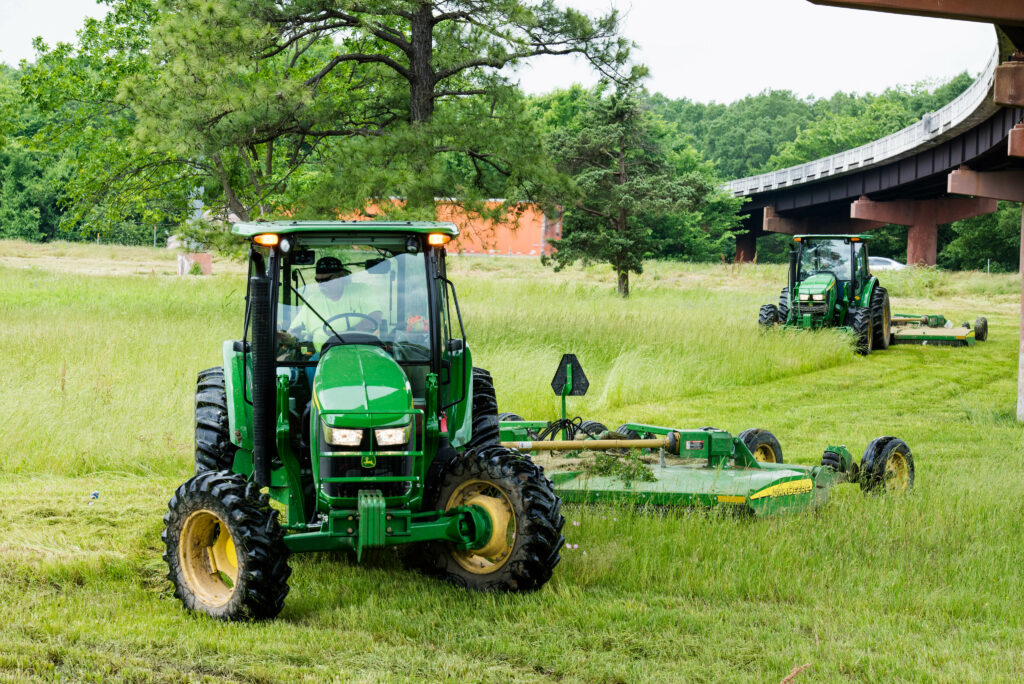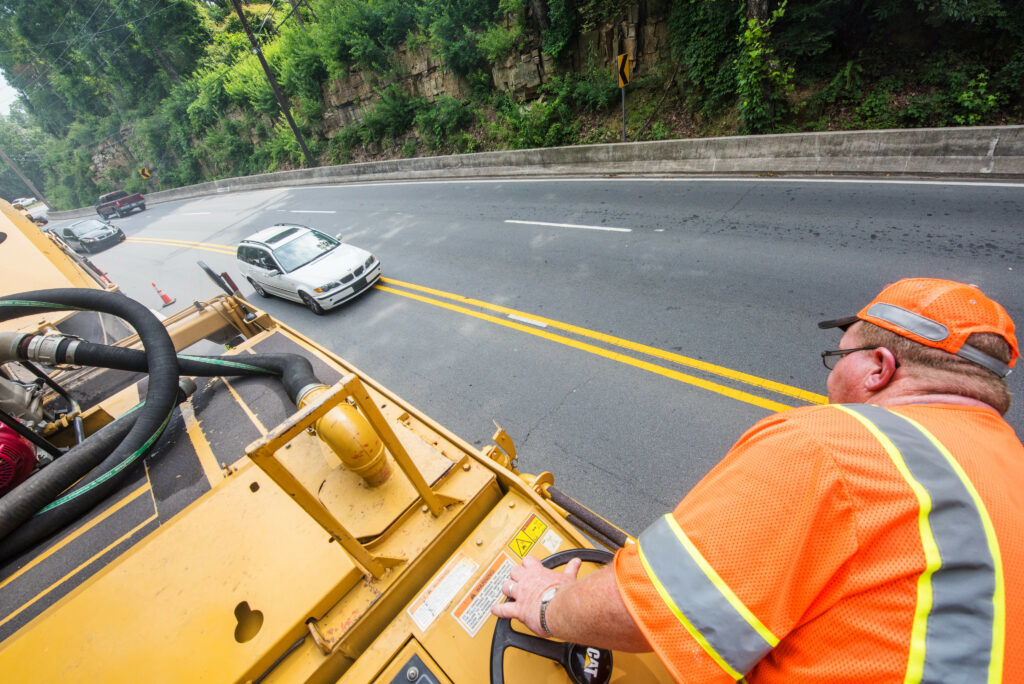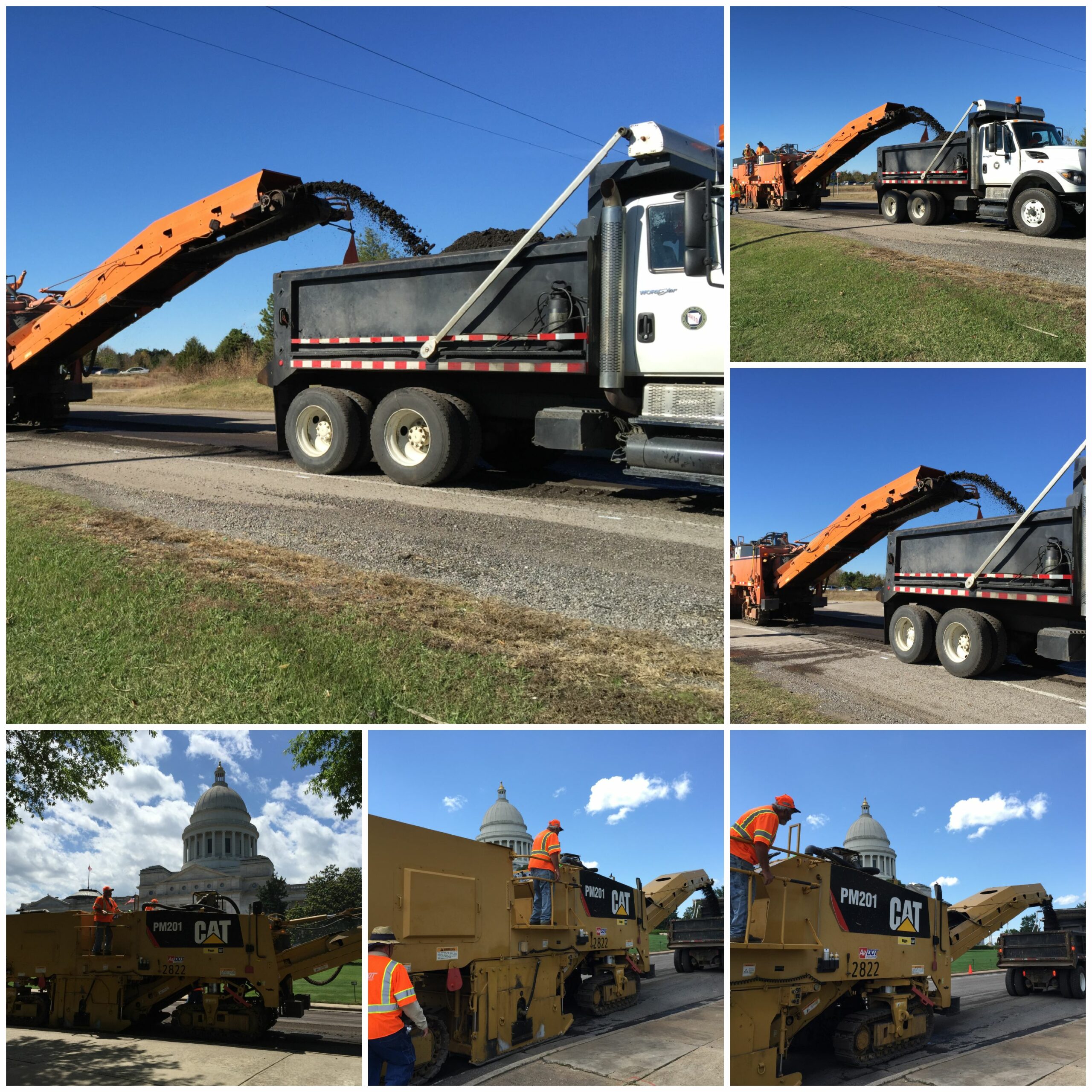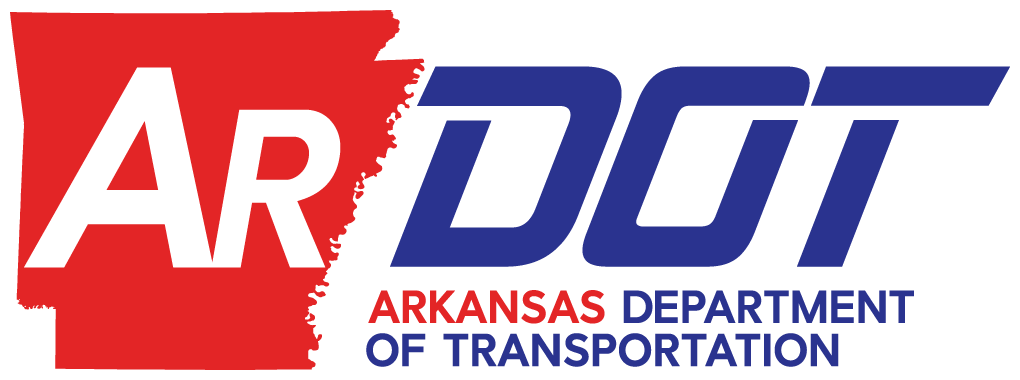







The following are the functions overseen by the Staff Maintenance Engineers of Maintenance Division:
Statewide Maintenance Crews
Pavement Marking
The Statewide Pavement Marking or Striping Crews are responsible for striping roadways upon completion of maintenance activities like minor overlays, large patches, and chip seals. The striping crews provides maintenance re-striping for faded or missing pavement marking by applying waterborne traffic paint or thermoplastic pavement marking with reflective glass beads.
The Striping Superintendents coordinate with district maintenance & construction personnel to investigate passing sight distance and recommend installation of passing and no-passing zones as well as other pavement marking needs.
Each week a striping schedule is prepared by the Striping Superintendent and distributed to central office operations Staff and to each District. This schedule lists the routes and sections where the work is being performed and the type of work being performed by each crew. It also lists the previous week’s accomplishments.
Pavement Profiling
The Statewide Pavement Profiling Crews are responsible for providing pavement-profiling (milling) services to the Districts. The purpose of pavement profiling is to remove asphalt and occasionally concrete from the roadway surface to restore a riding surface or as preparation for an overlay. The Division has two milling machines that operate throughout the state at locations requested by the Districts. The scheduling for these machines begins in January with a list from the Districts of the locations that they are aware of that will need milling in the upcoming year. The schedule has the flexibility to meet the changing needs of the Districts throughout the year.
Each crew consists of a Crew Leader, a Pavement Profiler Operator, and a Lowboy/ Float Truck Driver. The Job Superintendent supervises the daily operations of both crews. The crews are responsible for transporting, operating, and maintaining these machines and their supporting equipment. When the machine is milling, the operator is usually up on the machine’s platform operating the drum, steering the machine, and running the conveyer that is dumping material into the dump trucks. The crew leader and truck driver are on the ground checking the grade and slope of the cut as well as looking out for manhole covers, valves, or any other obstacles that may be in the roadway.
The District’s maintenance crews support the milling operation. The District provides traffic control, sweepers, water trucks, and dump trucks. The milled material is stockpiled and used for other roadway maintenance such as shoulder repair and drives.


Signing
The Statewide Sign Crews are responsible for signing installations on new construction and for maintenance re-signing of all freeway routes, U.S. routes and several high volume state routes. There are six sign crews in the Section. Two crews work on the maintenance of freeway signs and four crews work on new construction and maintenance re-signing of major routes. These crews typically install approximately 16,000 signs per year, the majority being re-signing of existing routes.
Each week a signing schedule is prepared by the Signing Superintendent and distributed to central office operations Staff and to each District. This schedule lists the routes and sections where the work is being performed and the type of work being performed by each crew. It also lists the previous week’s accomplishments. The Signing Superintendent also prepares signing logs for statewide Sign Crews and District Sign Crews. These logs list the locations of signs on a given section of roadway with recommendations for replacement, removal or relocation to conform to current standards. Signs are routinely replaced on a fifteen-year cycle, due to the anticipated performance of the retroreflective sheeting.

Sign Fabrication Shop
The sign shop under the direction of the Sign Shop Supervisor manufactures nearly all of the signs used on the Highway System. The Districts order signs through ORACLE. The Signing Superintendent also orders signs for installation by statewide sign crews.
The sign shop manufactures approximately 60,000 signs per year, most of which are regulatory, warning, and guide signs. All signs conform to the MUTCD (Manual on Uniform Traffic Control Devices) published by FHWA.

Traffic Operations Studies
Studies that are conducted at high accident rate locations often result in safety projects funded by the FHWA. Each week a traffic operations studies list is produced and distributed along with the signing schedule.
Interstate Signing Contracts
Plans and specifications for freeway signing contracts are prepared by Traffic Operations Personnel. Signing plans by consultants on freeway projects are also reviewed.
District Maintenance Allotment
These are the various allotments available to the districts to do their maintenance work:
– District Maintenance Expense Budget
– Pavement Preservation Program
– Contract Mowing Funds
– Equipment Replacement Funds
Vegetation Management
Maintenance is responsible for the design and implementation of the Department’s Vegetation Management Program; and guidance in Roadside Development, including the establishment and maintenance of turf, both by chemical and mechanical means.
The Department’s Agronomist is responsible for the coordination of Certification/Re-certification meetings with the University of Arkansas Cooperative Extension Service to ensure Right-of-Way Certification for Department employees.
Vegetation management along highway rights of way affords the following:
– To maintain the integrity of the paved surface
– To prevent or reduce erosion
– To provide for the safety of the traveling public
– To provide for efficient maintenance practices
– To maintain drainage
– To provide an aesthetically pleasing right of way
Vegetation management consists of both mechanical and chemical means. Mechanical methods of vegetation control include hand pulling, cultivation, trimming, and mowing. Chemical methods include the application of approved herbicides to control or suppress problem vegetation. Herbicide use is a key element to be used in combination with mechanical methods for roadside vegetation management.
Well-trained and well-informed personnel are necessary for the success of this program. A “Daily Herbicide Spray Report” is completed for every application and kept on file for a period of two years. Each is trained by the University of Arkansas Cooperative Extension Service; then, by passing an exam administered by the State Plant Board, certified in the Rights of Way category.
The Department is committed to landscape establishment / maintenance of ornamental shrubs, trees, and ground cover statewide, including assisting the Districts at their facilities and at designated Welcome Centers and rest areas. Landscaping provides a visually appealing environment for the user and safeguards to protect the quality and integrity of the existing environment. Utilizing Integrated Pest Management (IPM), mechanical, chemical and biological control, the Department is committed to providing a safe, efficient, aesthetically pleasing environment for the travelling public.
Mowing Guidelines
Contract Mowing:
The following criteria are used to establish contract mowing jobs quantities:
All routes will be mowed three times:- Prior to the observed date for Memorial Day
– During the month of July
– Between October 1 and Thanksgiving
Mowing cycles will be completed within a two-week period following 10 day advanced notification by the District Engineer. Maintenance Division will coordinate the notices to begin mowing.
Pre-emerge herbicides will not be applied to contract routes.
Mowing widths or schedules may be modified to accommodate certain established wild flower areas. Litter removal will be included in all contract-mowing jobs.
Jobs will be let in January each year.
Contracts may be for a total of seven years (a one year contract with six one-year-renewals). Mowing widths on Interstate and other divided or multi-lane routes will be mowed according to current policies. Use the current contract quantity sheet form to record specific locations, widths and quantities on divided highway plans. 30’ right and left every cycle. Leave nothing less than 30’ in medians and interchanges.
Mow drainages and to frontage roads as needed. In transition area of ramps mow to fence if the adjoining property is occupied, cleared or otherwise maintained. Where others want you to mow outside of our mowing limits, provide them with a permit or some form of acknowledgement to allow them to mow in accordance with the law.
Non-divided routes:
Mowing contracts on non-divided routes will be assembled such that most contracts are for 300 – 500 acres for the final mowing. Swath widths on first and second mowing will be 10’ wide measured from the nearest paved surface (roadway or shoulder). The swath width for the final mowing will be 30′ from the pavement edge or less depending on distance to right-of-way, non-movable area, or well established vegetation lines. “Good Neighbor Areas” may be mowed to the width and frequency (up to 3 cycles) necessary to maintain continuity with the adjoining property.
On non-divided routes Mow up to full R/W width every cycle in front of people’s homes where they might stop their mowing at the R/W line. Mow full width every cycle within urban parts of cities or towns. Mow full width on final mowing cycle along frontage of properties that are cleared and maintained by cultivating, mowing, grazing, or haying. For wooded or brushy property or where requested by the property owner, mow the 30’ maximum width as described above. Use the standard “quantities form” to compute the quantities on contracts to be advertised for bids or to revise quantities on existing jobs planned for renewal.
State Forces mowing
To provide consistency between the State and the Contract mowing programs, the following guidelines have been approved for the routes to be mowed by State Forces:
All routes will be mowed three times:- Prior to the observed date for Memorial Day
– During the month of July
– Between October 1 and Thanksgiving
Mowing is to begin during week of April 15th. Adjustments can be made as necessary for routes that remain in the Pre-emerge Herbicide Program. Mowing widths or schedules may be modified to accommodate certain established wild flower areas. Swath widths on first and second mowings will be 10′ wide measured from the nearest paved surface (roadway or shoulder).The swath width for the final mowing will be 30′ from the pavement edge or less depending on distance to right-of-way or non-mowable well-established vegetation and as follows:
On non-divided routes:
Mow up to full R/W width every cycle in front of people’s homes where they might stop their mowing at the R/W line. Mow full width every cycle within urban parts of cities or towns. Mow full width on final mowing cycle along frontage of properties that are cleared and maintained by cultivating, mowing, grazing, or haying. For wooded or brushy property or where requested by the property owner, mow the 30 maximum width as described above. It is recognized that due to manpower and equipment limitations, total compliance with the guidelines may not be accomplished on all routes. Priorities based on usage and continuity may be required.
Emergency Management
ARDOT Emergency Management provides expertise, programs and services to help the department prepare for, respond to, recover from and mitigate against natural disasters and other emergencies affecting the department and Arkansas’ transportation network.
The Emergency Management Coordinator & a Staff Maintenance Engineer serves as the Department’s Emergency Management Liaisons to the Arkansas Division of Emergency Management (ADEM), other state agencies, and local county Offices of Emergency Management (OEM).
Maintenance Management
Beginning in 1972 it became the goal of the Maintenance Division to organize state force resources and establish various levels of maintenance needed to keep the system in sound condition.
Of optimum interest is maintaining a common “ focal point “. Although goals are consistent, local conditions often dictate a different route to the same result. There is not only the question of what to do and how to do it, but how to pay for it and fit it into a daily routine.
The Arkansas State Highway system consists of 16,000+ 2-lane miles of roads. The District maintenance responsibility varies from as low as 1,639 to 2,012 two lane miles.
